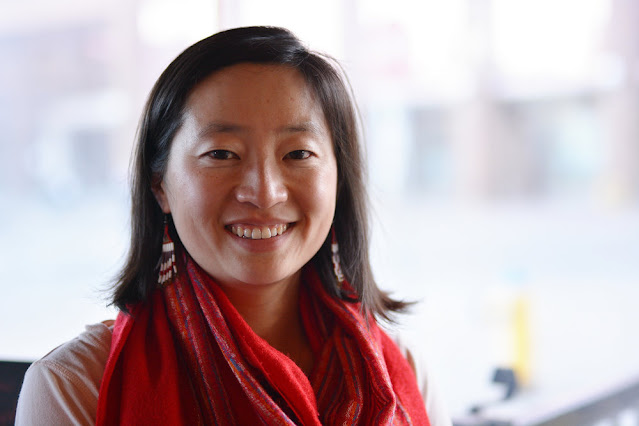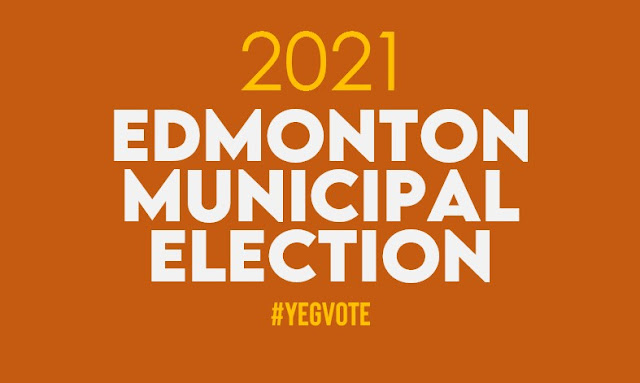Get to Know Who's Running: Keren Tang (Ward Karhiio)
 |
| Keren Tang |
I am running for city council because today, more than ever, we need leaders that can restore trust in democracy, renew our faith in each other, and unleash our collective creativity to build a city that works as well today as it will for our grandchildren.
I’m a bridge-builder. I’m a facilitator. I’m a doer. I look forward to doing a heck of a lot with Edmontonians as your City Councillor.
To learn more, visit my blog here.1. A people-centred approach to decision making
In my work experience, I have had many opportunities to lead people-based processes.
One that has left a deep impression on me is the Recover project that I worked on at the City of Edmonton. At its core, Recover is about city staff working alongside community members, first to listen with empathy to the stories of people who are houseless and living rough, and then translate those lived experiences into actions by bringing communities, businesses, governments, and agencies together.
I am currently applying this people-centred approach to reimagining neighbourhoods and social infrastructure with the Participatory Canada initiative at the McConnell Foundation. Working with international, national, and local partners in 3 Canadian cities, we are testing approaches to build large-scale resident-led networks of shops, makerspaces, and programs at the neighbourhood-level. These infrastructures fosters social cohesion across differences as neighbours learn from each other in practical, everyday projects that are useful for them, and also benefit the larger community and the planet.
This is exactly what I believe an effective City Councillor should do and what I would do if elected as your City Councillor: walk side-by-side with my communities, seek to directly understand stories and expertise from Edmontonians, and experience firsthand the strengths and challenges from the ground. I firmly believe this will inform and facilitate stronger decision-making by city council.
2. Using a public health lens for policy making
Public health includes housing, accessibility, safety, and other fundamental prevention and promotion measures. I believe a City Councillor should always ask “how are our policies creating the conditions in our workplaces, schools, and neighbourhoods so that people are healthy and our communities are vibrant?”
Focusing on this question ensures a city’s policies and actions lead to a better quality of life for residents from all walks of life. To help answer this question and use this lens effectively, we need good information to understand the story of the current state of our city.
I have spent my entire professional career using this lens to shape public policy, most memorably as a Master’s student working with the Yellowknives Dene People in the Northwest Territories to execute a participatory research project that helped the community create their own health and wellness policies and programs that are rooted in their traditional cultural way of life. It was an outcome I helped to facilitate with the community rather than implementing a top-down strategy.
3. Working toward a just society for all Edmontonians
There is struggle in the world. The pandemic has intensified the inequality experienced by those struggling and has made their lives even more difficult.
But in a just society, we, regardless of our skin colour, gender, income, profession, age, sexual orientation, have the agency, resources, and networks to reach our full potential, on our own terms. To get there, we must work across sectors (governments, agencies, community organizations, neighbourhood groups, business associations) instead of in silos, such that information flows and reaches the right places. We acknowledge our differences but also what we share with one another. We are empathetic and understanding towards each other and help lift each other up.
I have extensive community organizing experience working with historically marginalized and vulnerable groups to achieve a more just and equitable society for all of us. I have served on the board of the Edmonton Multicultural Coalition and on the Edmonton Community Foundation, amplifying voices of communities of colour in Edmonton. I chaired the board of a national group called Girls Action Foundation and oversaw a massive restructuring of the organization to better work with local partners in building skills and confidence of girls from coast to coast. .
But the things that I love the most are getting involved with local, grassroots initiatives, such as the Bridges Against Hate Peace March that happened recently here in Edmonton in response to the rising hate and targeted attacks on racialized communities, and especially women of these communities. This march brought together Asian, Black, Muslim, Indigenous and LGBTQ2+ people - communities that are historically pitted against one another - in a powerful and beautiful show of solidarity. I helped organize the rally, co-MC’d the event, and hosted a community conversation afterwards where Edmontonians of different backgrounds came together to share their personal stories.
Economy: COVID-19 has crippled our small businesses. Although there is an ongoing recovery, things won't be back to the way they were for a long time. Strengthening small businesses is not only good for economic stability. Local businesses are also centres of vibrancy within their neighbourhoods. When those businesses struggle or go under, the neighbourhood also struggles, and other issues emerge like reduced safety and security. Investing back in our local economy can help us achieve multiple positive outcomes and improve quality of life. Ultimately the best thing a city can do for the economy is create liveable neighbourhoods, making Edmonton attractive to entrepreneurs, workers, and investors.
City decision-making: People are frustrated. I’m hearing time and time again the frustration with how decisions are made, who’s making them, and who is benefitting from them. As our communities recover from COVID-19, they’re going to need even more help and a greater say in how decisions are made. Communities are their own experts, and therefore know what works best for them. I want to explore collective decision-making tools that can facilitate greater community partnership, placemaking, and programming that nurture more neighbour-to-neighbour relationships. These processes can set an example for larger budget decisions
Concerns over community safety and policing: In May 2020, the murder of George Floyd by Minneapolis Police Officer Derek Chauvin ignited protests against the long-standing and far-reaching issues of racism in policing and the resulting police brutality against people of colour. Today, we are reconsidering how we are training our police officers and if we are equipping the right people with the right set of tools to address the myriad social challenges they work to resolve on a daily basis. A key consideration is whether we are being proactive, empathetic, and compassionate in our community policing strategy. Many of the calls require de-escalation of situations rooted in mental health, addiction, and trauma. The next city council will have an historic opportunity to work with a broad spectrum of actors to reimagine our policing services to achieve better outcomes for Edmontonians.
Impact of global challenges: Many of the issues that matter to residents are big and incredibly complex. They are also global in nature. Issues like climate change, racism, housing, and income inequality often involve multiple layers of governments, and systems and sectors that influence and interconnect with each other. The call to action often focuses at the policy and systemic levels that take time to develop and even longer to implement. But are there more tangible things we can do at the hyperlocal, neighbourhood, and even interpersonal levels to generate small change? What if we focused on: improving our transit and local connectedness for better mobility, fostering spaces where people of diverse backgrounds can interact as peers, housing projects that meet the diverse needs of community members? I firmly believe that solutions to these large problems start in our homes and neighbourhoods. I believe that the role of a City Councillor is to facilitate, help connect the dots, and amplify the work and solutions percolating in the community.public health,
mobility,
community building,
local economy,
and accountability.
These topics will be the focus of our campaign. For more information on what is included in each of these topics, please visit my blog at kerentang.ca.
CITYlab: The current conversation at City Hall about a Street Lab program to improve traffic safety within neighbourhoods reminds me much of the older CityLab initiative, which was to advance the urban planning conversation with placemaking throughout the city. This focus on small-scale, tactical projects made the prospect of the city’s development more accessible to a bigger and more diverse number of Edmontonians.
Open Window: This is a small, not very well known program housed within the City’s local economy team, designed to help small business owners and aspiring business owners navigate the system by putting them in touch with people and organizations that could help them. Small, locally-owned businesses are the heart of our community, so it’s imperative that the city do whatever it can to support them. A program like this responds to business owners on a case-by-case basis as individual needs and questions vary so widely.
Opening the Potential: This is a mentorship program coordinated through the Women’s Initiative at the City. The last session back in 2016/2017 was a campaign school format for women interested in politics. I was one of 50 or so women part of the program, at times joining in with my infant daughter. I benefited greatly from the networking and the knowledge sharing. Many of my peers actively supported my campaign back in 2017 as volunteers and donors, and I’ve remained in touch with many of them even collaborating on initiatives. Today, training like this has largely transitioned to work led by organizations like Parity YEG and Equal Voice to continue fostering that community of support.
Kihciy askiy (Sacred Earth) Project: The first urban Indigenous cultural and ceremonial land space in Canada is located at the former site of Fox Farms in the Whitemud Park. This project has been in the works for a number of years and is stewarded by the Indigenous Knowledge and Wisdom Centre in partnership with the City. This unique project has been led with the continued guidance and support of the City of Edmonton, First Nations Leadership, and a Counsel of Indigenous Elders from the Capitol region and Alberta. Built upon a common set of principles and values as its foundation, the kihicy askiy project has provided the opportunity to develop a meaningful and respectful partnership with the City.
The EEDC (Edmonton Economic Development Corporation) transition plan was a lost opportunity for the city over the last 12-18 months. I believe it was the right move to separate Innovate Edmonton from EEDC and to set-up a new entity tasked with catalyzing innovation in our city; however in doing so, the city left EEDC in limbo and without leadership. At the time of the transition, I would have considered re-allocating a portion of the EEDC budget directly to Edmonton Global, an arm’s length not-for-profit whose mission is to radically transform and grow the economy of the Edmonton Metropolitan Region. We could have given a strong boost to the organization that is best positioned to catalyze global investment into our region.
The Council Initiative on Public Engagement several years ago was a massive undertaking that involved a ton of resources, time, and energy from community members, administration, and elected officials. The second version of this was the Guiding Coalition on Public Engagement, of which I was honoured to be a part of. But this coalition did not have the teeth to make the changes required to bolster our city’s public engagement strategy. Instead of trying to coordinate a volunteer committee that has no resources or capacity to enact tangible change, we need to focus on the user experience of our citizens when interacting with city services. If it were up to me, I would focus the public engagement branch on testing out user experiences to drive improvement and facilitate services that meet the needs and account for the lived realities of everyday Edmontonians. This process can be applied across the board from a small community garden project to improving transit ridership and winter emergency responses for vulnerable populations.
One way I think that Edmonton could have handled this crisis differently (and more smoothly!) is by strengthening municipal public health initiatives, much like in many other cities around the world. Public health initiatives advocate for better data collection and disaggregated data in the city (which means we can see what is going on geographically and demographically), and identify neighbourhoods that are being hardest hit by the pandemic, allowing for faster action and deployment of support on the ground. This stronger data capacity and public health authority would allow us to be agile and more responsive to emerging needs to address the crisis. While increasing Edmonton’s public health capacity has complex jurisdictional implications (i.e., health services and public health are traditionally provincial responsibilities), understanding this information creates an opportunity for better collaboration with the province. Learn more about my public health perspective in my blog here.



Comments
Post a Comment